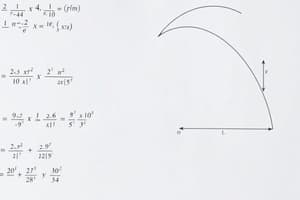Podcast
Questions and Answers
Refer to the graph shown. Write down the coordinates of the vertex.
Refer to the graph shown. Write down the coordinates of the vertex.
(4, 1)
Refer to the graph shown. Write the equation in the form y = 3(x − h)² + k
Refer to the graph shown. Write the equation in the form y = 3(x − h)² + k
y = 3(x - 4)² + 1
Refer to the graph shown. Write down the equation of the axis of symmetry.
Refer to the graph shown. Write down the equation of the axis of symmetry.
x = 4
Refer to the graph shown. Write down the domain and range.
Refer to the graph shown. Write down the domain and range.
Write down the coordinates of the vertex.
Write down the coordinates of the vertex.
Sketch the graph of the parent quadratic, y = _x_², and the graph of y = g(x) on the same axes. Then write down the coordinates of the vertex and the equation of the axis of symmetry for the graph of g. g(x) = (x + 3)²
Sketch the graph of the parent quadratic, y = _x_², and the graph of y = g(x) on the same axes. Then write down the coordinates of the vertex and the equation of the axis of symmetry for the graph of g. g(x) = (x + 3)²
Sketch the graph of the parent quadratic, y = _x_², and the graph of y = g(x) on the same axes. Then write down the coordinates of the vertex and the equation of the axis of symmetry for the graph of g. g(x) = −_x_² + 4
Sketch the graph of the parent quadratic, y = _x_², and the graph of y = g(x) on the same axes. Then write down the coordinates of the vertex and the equation of the axis of symmetry for the graph of g. g(x) = −_x_² + 4
Sketch the graph of the parent quadratic, y = _x_², and the graph of y = g(x) on the same axes. Then write down the coordinates of the vertex and the equation of the axis of symmetry for the graph of g. g(x) = 2(x − 4)² − 3
Sketch the graph of the parent quadratic, y = _x_², and the graph of y = g(x) on the same axes. Then write down the coordinates of the vertex and the equation of the axis of symmetry for the graph of g. g(x) = 2(x − 4)² − 3
Describe the transformations of the graph of f(x) = _x_² that lead to the graph of g. Then write an equation for g(x).
Describe the transformations of the graph of f(x) = _x_² that lead to the graph of g. Then write an equation for g(x).
What are the x-intercepts of the quadratic function f(x) = (x - 3)^2 - 2?
What are the x-intercepts of the quadratic function f(x) = (x - 3)^2 - 2?
Find the coordinates of the vertex of the quadratic function f(x) = -2x^2 + 4x - 8?
Find the coordinates of the vertex of the quadratic function f(x) = -2x^2 + 4x - 8?
Match the following transformations with the corresponding effect on the graph of the quadratic function f(x) = x^2:
Match the following transformations with the corresponding effect on the graph of the quadratic function f(x) = x^2:
Find the equation of the axis of symmetry for the function f(x) = 3x^2 + 18x + 20?
Find the equation of the axis of symmetry for the function f(x) = 3x^2 + 18x + 20?
What are the x-intercepts of the quadratic function f(x) = x^2-12x+36?
What are the x-intercepts of the quadratic function f(x) = x^2-12x+36?
Find the coordinates of the point of intersection between the graphs of the functions f(x) = x^2 - 8x + 5 and g(x) = 3x^2 - 6x + 2?
Find the coordinates of the point of intersection between the graphs of the functions f(x) = x^2 - 8x + 5 and g(x) = 3x^2 - 6x + 2?
The graphs of the functions f(x) = x^2 - 8x + 5 and g(x) = -2x^2 - 8x - 11 intersect at two points.
The graphs of the functions f(x) = x^2 - 8x + 5 and g(x) = -2x^2 - 8x - 11 intersect at two points.
What is the equation of the axis of symmetry for the quadratic function f(x) = 2(x + 3)(x - 1)?
What is the equation of the axis of symmetry for the quadratic function f(x) = 2(x + 3)(x - 1)?
Find the coordinates of the vertex of the quadratic function f(x) = -3(x - 2)^2 + 5?
Find the coordinates of the vertex of the quadratic function f(x) = -3(x - 2)^2 + 5?
What are the x-intercepts of the quadratic function f(x) = 2x^2 + 6x + 3?
What are the x-intercepts of the quadratic function f(x) = 2x^2 + 6x + 3?
What is the equation of the axis of symmetry of the function f(x) = 4(x + 3)(x - 1)?
What is the equation of the axis of symmetry of the function f(x) = 4(x + 3)(x - 1)?
Flashcards
Vertex of a Parabola
Vertex of a Parabola
The turning point of a parabola, representing the minimum or maximum value of the function.
Axis of Symmetry
Axis of Symmetry
A vertical line that divides a parabola into two symmetrical halves.
Parabola Equation (Vertex Form)
Parabola Equation (Vertex Form)
𝑦 = 𝑎(𝑥−ℎ)^2 + 𝑘 where (h,k) is the vertex and a affects the shape.
Domain
Domain
Signup and view all the flashcards
Range
Range
Signup and view all the flashcards
Quadratic Function
Quadratic Function
Signup and view all the flashcards
Parabola Intercept
Parabola Intercept
Signup and view all the flashcards
Maximum Height
Maximum Height
Signup and view all the flashcards
Time of Flight
Time of Flight
Signup and view all the flashcards
Projectile Motion
Projectile Motion
Signup and view all the flashcards
Height of Projectile
Height of Projectile
Signup and view all the flashcards
Initial Velocity
Initial Velocity
Signup and view all the flashcards
Initial Height
Initial Height
Signup and view all the flashcards
Horizontal Distance
Horizontal Distance
Signup and view all the flashcards
Time
Time
Signup and view all the flashcards
Assembly Rate
Assembly Rate
Signup and view all the flashcards
Parabola
Parabola
Signup and view all the flashcards
Vertex
Vertex
Signup and view all the flashcards
Standard Form (Quadratic)
Standard Form (Quadratic)
Signup and view all the flashcards
Vertex Form (Quadratic)
Vertex Form (Quadratic)
Signup and view all the flashcards
Intercept Form (Quadratic Function)
Intercept Form (Quadratic Function)
Signup and view all the flashcards
X-Intercepts (Quadratic Function)
X-Intercepts (Quadratic Function)
Signup and view all the flashcards
Quadratic Equations
Quadratic Equations
Signup and view all the flashcards
Points of Intersection
Points of Intersection
Signup and view all the flashcards
Solving Quadratic Equation
Solving Quadratic Equation
Signup and view all the flashcards
Quadratic Formula
Quadratic Formula
Signup and view all the flashcards
Factoring (Quadratic Equations)
Factoring (Quadratic Equations)
Signup and view all the flashcards
Solution to Quadratic Equation
Solution to Quadratic Equation
Signup and view all the flashcards
Real Solutions (Quadratic Equation)
Real Solutions (Quadratic Equation)
Signup and view all the flashcards
No Real Solutions (Intersecting Graphs)
No Real Solutions (Intersecting Graphs)
Signup and view all the flashcards
Applications of Intersections
Applications of Intersections
Signup and view all the flashcards
Supply and Demand
Supply and Demand
Signup and view all the flashcards
Understanding Quadratic Functions
Understanding Quadratic Functions
Signup and view all the flashcards
Modeling Real-World Phenomena
Modeling Real-World Phenomena
Signup and view all the flashcards
Problem-Solving Strategies
Problem-Solving Strategies
Signup and view all the flashcards
Interpreting Results
Interpreting Results
Signup and view all the flashcards
Coordinate System
Coordinate System
Signup and view all the flashcards
Cartesian Plane
Cartesian Plane
Signup and view all the flashcards
Ordered Pair
Ordered Pair
Signup and view all the flashcards
Graphing Techniques
Graphing Techniques
Signup and view all the flashcards
Mathematical Modeling
Mathematical Modeling
Signup and view all the flashcards
Solving for X
Solving for X
Signup and view all the flashcards
Solving for Y
Solving for Y
Signup and view all the flashcards
Algebraic Techniques
Algebraic Techniques
Signup and view all the flashcards
Study Notes
Quadratic Functions and Transformations
- Various quadratic functions are presented, along with their corresponding graphs.
- Key features, such as vertex coordinates, intercepts, axis of symmetry, domain, and range, are identified for each function.
- Students need to label these key features on sketches of the functions.
Exercise 3J
- Problems involve sketching parent quadratic functions (y = x²) and related functions (g(x)) on the same axes.
- Coordinates of the vertex and the axis of symmetry need to be determined for each transformed quadratic.
Exercise 3L
- Students use a graphing calculator (GDC) to plot quadratic functions.
- Key features (x-intercepts, y-intercepts, vertex) need to be identified and labeled on the graph.
- Domain and range of the functions are required.
Exercise 3M
- Problems focus on determining the equation of symmetry, coordinates of the vertex, and y-intercept of various quadratic functions.
Exercise 3N
- Students are required to express quadratic functions in the form f(x) = a(x - p)(x - q), where p > q.
- Finding the x-intercepts and y-intercept coordinates of the function is also part of this exercise.
Exercise 3R
- Finding the exact values and graphical solutions for quadratic equations.
- Determining the points of intersection of specified quadratic and linear functions through graphical methods.
Exercise 3W
- Solving quadratic inequalities graphically.
- Identifying the values of constants that cause quadratic equations to have two distinct real roots or no real roots.
Exercise 3X
- The length of the base of a triangle is related to its height and area. A function models the ball's height over time.
Exercise 30
- Finding the expression for quadratic functions using given information from their graphs.
Exercise 3P
- Various problems involving quadratic functions and their transformations.
Exercise 3S
- A variety of problems related to quadratic functions require finding key features such as roots, vertex, and symmetry. A variety of quadratic problems.
Exam-Style Questions
- Problem types related to quadratic functions and their transformations appear throughout the exercises.
- Finding solutions and describing these types of transformations of the functions are frequent tasks.
Review
- Problems involve identifying features of graphs of quadratic functions and calculating important components like the vertex, axis of symmetry, and intercepts, as well as describing transformations.
Studying That Suits You
Use AI to generate personalized quizzes and flashcards to suit your learning preferences.




